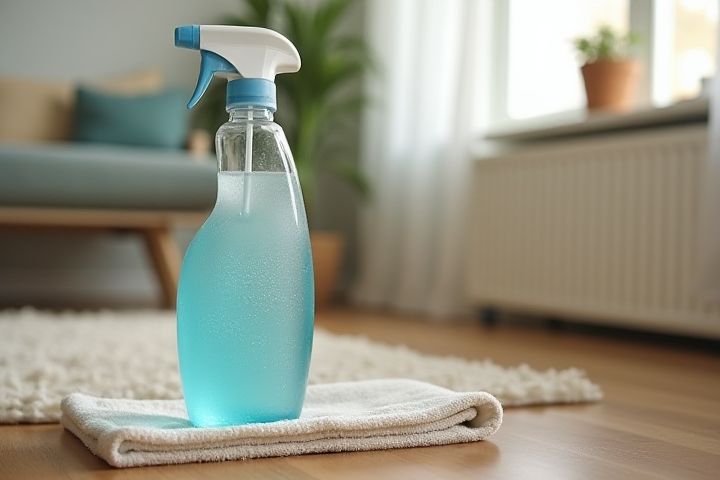
Regularly decluttering your living spaces is essential for maintaining a clean home, as it minimizes accumulated dust and creates a more organized environment. Establish a consistent cleaning schedule that incorporates daily, weekly, and monthly tasks, ensuring that every area of your house receives attention. Utilize eco-friendly cleaning products, which not only protect your family's health but also contribute to a sustainable lifestyle. Incorporating storage solutions, such as bins and shelves, can help you keep items in their designated places, reducing mess. Finally, involving every member of your household in cleaning chores fosters a sense of responsibility and teamwork in maintaining a tidy home.
Ways To Keep A House Clean
Regular cleaning schedule
Establishing a regular cleaning schedule is vital for maintaining a pristine home environment. Consider dedicating specific days for tasks such as vacuuming, dusting, and mopping, ensuring each area receives attention on a rotating basis. For optimal results, aim for a 15-30 minute daily cleaning routine that tackles small tasks, preventing clutter accumulation. Use a checklist to track your progress and adjust your schedule as needed, empowering you to manage your cleaning effectively.
Decluttering habits
Establishing decluttering habits can significantly enhance the cleanliness of your home, making it easier to maintain an organized space. Start by dedicating just 10-15 minutes daily to remove unnecessary items, focusing on one room at a time to prevent feeling overwhelmed. Implement a "one in, one out" rule, ensuring that for every new item you bring into your house, you dispose of or donate an existing item. Regularly assess your belongings every three months, allowing you to keep track of unused items and make conscious decisions about what you truly need.
Efficient storage solutions
Maximize your space by investing in multifunctional furniture, such as ottomans with hidden storage or beds with built-in drawers, which can significantly reduce clutter. Utilize vertical space by installing shelves or wall-mounted cabinets, allowing you to store items off the floor and making cleaning more manageable. Implement clear bins and labels in closets to easily identify contents and encourage consistent organization, allowing you to quickly locate what you need. Finally, consider assigning a dedicated spot for items like shoes or bags near entrances to streamline daily routines and maintain a tidier home.
Vacuuming and sweeping techniques
Effective vacuuming requires selecting the right vacuum cleaner for your flooring type; for carpets, a model with strong suction and rotating brushes is ideal, while hardwood floors benefit from a vacuum that includes a soft brush attachment. Regularly vacuum high-traffic areas at least twice a week to prevent dirt buildup and extend the life of your flooring. Sweeping techniques can enhance your cleaning routine; use a microfiber broom for dust capture, and always sweep in a consistent direction to gather debris into one pile. Remember to sweep corners and under furniture where dirt tends to accumulate, ensuring a thorough clean every time.
Dust-proofing methods
Implementing dust-proofing methods is essential for maintaining a clean home environment. Start by sealing gaps around windows and doors with weather stripping, significantly reducing the entry of dust particles. Invest in high-quality HEPA filters for your HVAC system and vacuum cleaners, capturing up to 99.97% of airborne allergens. Regularly wash curtains and upholstery in hot water, ideally bi-weekly, as this can eliminate dust mites and associated debris.
Mold and mildew prevention
To effectively prevent mold and mildew in your home, maintain indoor humidity levels below 50% using dehumidifiers or air conditioners. Regularly inspect areas prone to dampness, such as bathrooms, kitchens, and basements, ensuring proper ventilation, which reduces moisture buildup. Clean and dry any spills or leaks immediately, and wash bathroom surfaces with mold-inhibiting cleaners weekly. To enhance air circulation, keep furniture away from walls and use exhaust fans when cooking or showering, promoting a drier and healthier living environment.
Stain removal practices
To effectively remove stains, promptly address spills to prevent them from setting; this is crucial for maintaining your home's cleanliness. Utilize a 3:1 mixture of water and white vinegar for common stains like coffee and juice; this solution can be applied directly with a cloth for best results. For tougher stains, such as red wine, sprinkle salt immediately to absorb the liquid, then rinse with cold water. Don't forget to always test a cleaning solution on an inconspicuous area first to ensure it won't damage your surfaces.
Air quality maintenance
Maintaining indoor air quality significantly enhances your home's cleanliness and overall health. Regularly replacing HVAC filters, ideally every 3 months, ensures dust and allergens are effectively trapped. Incorporating indoor plants, such as peace lilies or spider plants, can reduce airborne toxins while also adding aesthetic value to your space. Using air purifiers with HEPA filters can capture up to 99.97% of particulate matter, improving air quality and creating a fresher living environment.
Appropriate cleaning products
Choosing the right cleaning products is essential for maintaining a spotless home environment. For disinfecting surfaces, opt for EPA-approved sanitizers that eliminate 99.9% of germs. When tackling stubborn stains, utilize enzymatic cleaners for effective deep cleaning without damaging surfaces. To ensure eco-friendliness, consider biodegradable options, which combine efficacy with a lower environmental impact.
Family involvement strategies
Creating a clean home requires everyone's participation, especially when focusing on family involvement strategies. Implement a weekly cleaning schedule that allocates specific chores to each family member, ensuring tasks are age-appropriate and manageable. For example, younger children can help with dusting surfaces, while teenagers can tackle vacuuming and laundry. Establishing a reward system, such as a family outing, can motivate your family to take pride in maintaining a clean space together.
